|
FNH-USA continues to impress me with
their wide variety of handguns, rifles, and shotguns that are
built for military and law enforcement uses. All of the FNH
weapons are overbuilt for ruggedness and durability in the
toughest conditions, and for that reason, they are also ideally
suited for use by the rest of us as well. It really grates upon
my nerves when a self-proclaimed expert tries to tell us that
the average citizen does not need the same weapons as do law
enforcement officers. They say that the police need
high-capacity autoloaders, but that the ordinary homeowner does
not. This is probably the opposite of the truth. A law
enforcement officer usually has backup just moments away. A man
defending his home from a forceful invasion does not. Some
categorize “police” and “civilians”. This too is
incorrect. The police are civilians. They are
hired to protect us from the dregs of humanity, and on the
whole, they do a good job. However, unless you have your own
private cop at your side all day, everyday, you must protect
yourself and those for whom you are responsible. In a home
invasion or out on some lonely back road, you are on your own.
The police cannot be everywhere, and therefore, the average
citizen needs at his disposal the ability and hardware to defend
himself and his family. Keeping all this in mind, those weapons
that are often categorized as “tactical” and marketed
towards law enforcement are exactly what is needed when a man
must be his own police officer, which is almost always the case
when it comes to defending against a violent attack. I have
stated this before, but it bears repeating: the police are not
going to be at your side when an attack occurs. Even if you live
in a city where the response time is very good, help is at least
five minutes away, that is, if you have time to make the call.
As I have also used to illustrate my point before, do this
simple exercise. Imagine that your front door is kicked in. Grab
the phone, pretend to call 911, and then sit down and look at
the clock for a full five minutes. A lot can happen in five
minutes. The police can show up and draw a little chalk line
around your body, and around the bodies of those that are
dearest to you. Thinking of stuff like this is distasteful to
most of us, and hard to even contemplate, but in our society,
self defense is something for which we should prepare, and hope
to never need, just like car insurance, only on a much graver
scale. I stated the above to illustrate the need that each of us
has for “tactical” type weapons. I prefer to call them
fighting weapons myself, as “tactical” is a term that is
greatly overused, and often misused. While sporting and fighting
weapons can overlap and sometimes interchange, they differ in
their characteristics and handling qualities. For instance,
while a high-dollar Italian double shotgun that is built for
clay target shooting can be used to defend against a home
invader, a much shorter, handier shotgun with greater firepower
is preferred. Same with handguns. An Olympic free-style target
pistol is excellent for punching holes in paper, but is not
well-suited to hiding under a lightweight jacket. A compact .45
Auto is much better as a fighting gun. There are many in our
government who believe that we do not need to own fighting guns,
and at least one of our Presidential contenders for the 2008
election has stated that he intends to work towards banning
semi-auto weapons from civilian ownership in the USA, if he is
elected, and he probably will be. Just for the record, I don’t
have a lot of confidence in the other guy either. It just seems
that elitist politicians, who enjoy the protection of
around-the-clock armed guards, often forget that the average
citizen must protect himself.
That brings us back to the topic at hand;
fighting weapons, and more specifically the subject of this
review, the FS2000 carbine from FNH-USA. As stated above,
FNH makes some excellent fighting weapons. The FS2000 is a
semi-auto version of FNH’s F2000 carbine. The FS2000 is a
Bullpup design, meaning that it has no conventional buttstock as
do most carbines, but that the receiver of the carbine is at the
rear of the weapon, resulting in a much reduced overall length,
while still incorporating a carbine-length barrel. Being a
left-handed shooter, I have never been able to shoot Bullpup
carbines before, as most eject out the right side, which would
mean that the hot empty cases would be inserted into my ear
canal. There have been a couple of Bullpup designs which allow
for changing from right-hand to left-hand ejection, but it
involves changing out some internal parts. The FS2000 has
resolved this problem by ejecting the fired cases out the front
of the carbine, on the upper right side of the stock and below
the front sight. The fired cases eject through a tube that runs
atop the barrel inside the upper receiver section of the
carbine. At the ejection port is a hinged cover that remains
closed until four shots have been fired, at which time it opens
and begins dumping the fired cases to the right front of the
shooter. This is an excellent feature. On the firing line, the
cases are being ejected to the front, and are not hitting
another shooter to the side of the weapon. This is important
both on the range and in a fight. It is also noteworthy that by
not flinging the empty cases upon the ground for the first few
shots, if only a couple or three shots are needed to accomplish
the job, there are no empty cases lying upon the ground.
Depending upon the situation, this may or may not be of
importance. Besides the desire that we not litter, leaving fired
cartridge cases with fingerprints upon them might, in some
situations, be something that we do not want to do. Anyway, I
like this feature of the FS2000.
The FS2000 version reviewed here has a set of
good, adjustable backup sights, but wears a long Picatinny rail
atop the receiver for the mounting of an optical sight, such as
a scope or illuminated dot sight. The FS2000 has a barrel that
is approximately sixteen inches in length, with a very effective
muzzle brake attached, resulting in a total length of the barrel
with brake measuring seventeen and three-eighths inches. The gas
system has a piston rod running along the left side of the
barrel inside of the upper receiver. The gas system has a
two-position lever to allow for reliable functioning should the
weapon become excessively filthy or when using weak ammunition.
Good idea. The FS2000 uses readily available AR-15/M-16
thirty-round magazines. There is also a version available with a
ten-round magazine for those who are legally limited to that
capacity. The magazine release is ambidextrous and easy to use.
The magazines does not fall free of the weapon, but must be
pulled from the receiver to prevent inadvertently dumping a
magazine. The motion to remove the magazine is very natural.
Just by reaching and grabbing the magazine, the release is
activated by the hand. The safety is also ambidextrous and easy
to use, even while wearing gloves. The safety is located
conveniently just below the trigger. The cocking handle is on
the left side, and can be locked into the open position with an
upwards motion, similar to the H&K design. It is very
easy to use and quick into action. The trigger pull on the
sample rifle measured just over seven pounds. It is a very
smooth-feeling pull, and feels lighter than it measures. Trigger
travel is about one-half inch, and much like a light
double-action revolver's pull in feel. At the rear of the upper
receiver is a flip-up inspection port to view the condition of
the weapon’s action.
Field stripping the FS2000 is very easy to do
without tools. The cross pin for disassembly is large and
rectangular in section, and is retained in the receiver to
prevent loss. Pressing the pin out to the left allows the upper
section of the receiver to slide forward, taking with it the
barrel and gas system. The bolt carrier/operating rod can then
be pulled forward and out of the receiver. The procedure is very
simple and straightforward. Both sections of the receiver are
made of plastic, vertically split and held together with through
bolts. I made no attempt to take the halves apart, as it is not
necessary for cleaning or lubrication of the carbine.
The ergonomics of the FS2000 are very good. The
carbine weighs seven pounds, nine and one-half ounces unloaded,
and measures just a hair over twenty-nine inches in length. This
makes for a very handy size to maneuver in tight quarters such
as a hallway or the inside of a vehicle.
For shooting the FS2000, I mounted a 3.5 power
Trijicon
ACOG scope atop the Picatinny rail. The ACOG is compact,
rugged, and ideally suited for the FS2000, and the combination
worked very well. The ACOG has a tritium-illuminated reticle
that never needs batteries, and works well in any lighting
condition, from bright sunlight to almost total darkness. For
accuracy testing, I mounted a Leupold 6.5 to 20 power
scope attached with an ArmaLite mount. This scope is used
as my “mule” scope for accuracy testing. I trust it, and it
has never let me down. The Bullpup configuration and smooth,
flowing curves of the FS2000 made bench shooting difficult, as
it was hard to get it to lie within the rifle rest. However, I
was able to fire some pretty good groups from the carbine. The
accuracy of the FS2000 was very good with most ammunition, and
even better with a couple of loads. Most of the mil-spec ammo
grouped into about two to two-and-one-half inches at 100 yards,
but Winchester USA 62 grain ammo performed much better,
and would keep five shots under one and three-quarters inches.
At longer distances, I used the ACOG on the FS2000 to plink at
rocks and such. Offhand shooting is the carbine’s forte, and
it proved exceptionally easy to shoot well. Reliability of the
FS2000 was perfect during testing, when I didn’t screw up by
not fully inserting the magazine. Like with an AR, a good tap on
the bottom of the magazine will assure that it is fully seated.
While not designed to be a sporting weapon, the
FS2000 possesses the accuracy needed for predator hunting for
use on coyotes and such, and can be used as a walking varminter
for groundhogs, crows, and beaver. Using the right bullet, the
.223 is very useful for hunting whitetail deer where legal to do
so, and it would be fun to see the look on the game warden’s
face when he checked the rifle. As a competitive rifle for
tactical-type competition, the FS2000 should serve well, as it
is compact and easy to shoot. However, the FS2000 is built for
more serious purposes, and is a good choice for someone wanting
a reliable, compact 5.56mm alternative to the AR-15. It is
shorter and handier in tight quarters, totally ambidextrous, and
is probably the best Bullpup ever built. I like it.
At the time of this writing, the MSRP on the
FS2000 Tactical is $2773.27, which ain’t cheap, but if you are
in the market for a Bullpup 5.56mm carbine, you never regret
buying the best.
Check out the FS2000 and other products from
FNH-USA online at www.fnhusa.com.
For the location of an FNH dealer near you,
click on the DEALER LOCATOR at www.lipseys.com.
To buy the FS2000 online, go to www.galleryofguns.com.
To look at the excellent ACOG and Leupold
scopes, go to www.trijicon.com
and www.leupold.com.
Jeff Quinn
| For a list of dealers where you can
buy this gun, go to: |
|
To buy this gun online, go to: |
 |
|

|
|

Compared to a 16-inch AR-15, the handy size of the
16-inch FS2000 is readily apparent.

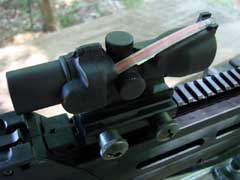

Author tested the FS2000 with 3.5x Trijicon ACOG (top)
and 6.5-20x Leupold scopes.


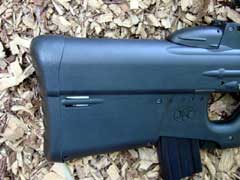


The FS2000 proved to be accurate, and 100% reliable,
with a good variety of ammunition.


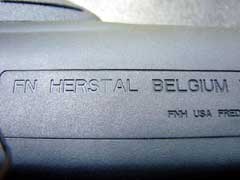

|
  
Got something to say about this article? Want to agree (or
disagree) with it? Click the following link to go to the GUNBlast Feedback Page.
|
Click pictures for a larger version.

FNH-USA's FS2000 Semi-Auto Bullpup Carbine.



Iron sights consist of protected-post front and flip-up
rear.



Muzzle brake.

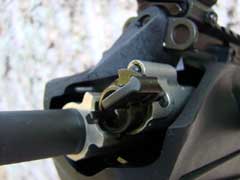
Adjustable gas system.

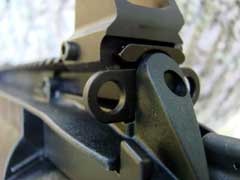

As befits the ambidextrous design, the FS2000 has sling
attachments on both sides.

Safety is also ambidextrous.

Charging handle.

The FS2000 uses cheap & plentiful AR-15/M-16
magazines.

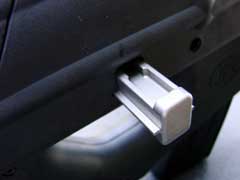
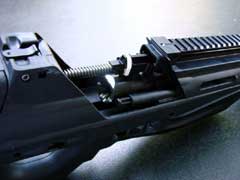


Disassembly is quick and easy, requiring no tools.


Inspection port.

The FS2000's ejection port is at the front of the stock.

|
![]()